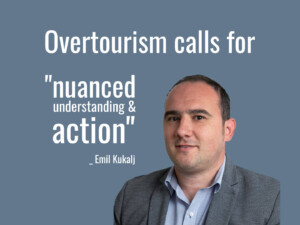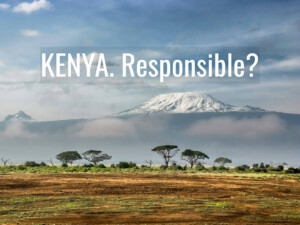“GT” Insight Bites: Diverse perspectives on visitor dispersion

An oft-cited antidote to overtourism, and a means to spread the benefits of tourism more widely, is ‘visitor dispersion’.
What are the biggest challenges to encouraging and incentivising tourists to explore more of a destination?
Who or what do you think could contribute most to effective visitor dispersion?
What can an organisation like yours do to encourage and incentivise dispersion?
For this “Insight bites”, your correspondent put the proposition and questions above to a range of travel & tourism stakeholders, and invited written responses of up to 300 words.
- Chris Flynn — First prepare traveller dispersal points
- Thomas Bauer — City sights will remain priorities for first-time visitors
- Lauren Uğur — Local ambassador programs may help disperse visitors
- Jonathon Day — Questioning the common wisdom about visitor dispersion
- Ben Lynam — Visitor dispersion may not be right for all destinations
- Catherine Germier-Hamel — Distributed visitor discovery centres may help
- Kevin Phun — Spreading people out needs serious, creative consideration
- K Michael Haywood — Not enough is known about visitor motivations
- Aayusha Prasain — Dispersing travellers in Nepal
- Tim Russell — Preconceptions, infrastructure pose challenges to dispersion
- John Roberts — Safety, comfort concerns for time-poor international visitors
- Karen Simmonds — Meaningful consultations begin with anyone selling travel
- Graham Harper — Determine correct carrying capacity
- Willem Niemeijer — Private sector, NGO, and government collaboration needed
- What do you think?
First prepare traveller dispersal points
Chris Flynn, Executive Chairman, World Tourism Association for Culture & Heritage (WTACH)
Before we incentivise travellers to disperse, the most critical aspect of a dispersal plan is to ensure that those in the planned dispersal point (operators, residents, businesses) are fully aware, trained, and supportive of the plans.

In most cases this aspect is ignored or never considered.
Dispersal without these key factors, plus others, such as carrying capacity awareness, appropriate and/or suitable infrastructure facilities / investment etc. is merely shifting the problem somewhere else, which will only serve to replicate or compound the issue.
Without the above being in place or actioned then the negative impact of tourism will far outweigh any perceived benefits.
Dispersal is often thought of as an obvious or simple solution to overtourism during high visitation peak seasons. Without the appropriate plans, community engagement that serves to build responsible and sustainable tourism that, in turn, seeks to improve lives and local prosperity, then you’re merely shifting the problem to somewhere else. The problems this creates are all too obvious from destinations that have already got it wrong.
Who or what do you think could contribute most to effective visitor dispersion?
- Improved communications with affected communities
- Tourism training of local government, councils, operators, and businesses
What can an organisation like yours do to encourage and incentivise visitor dispersion?
All of the above. We have a complete tourism training portfolio to counter the negative effects of misguided tourism plans and strategies.
City sights will remain priorities for first-time visitors
Thomas Bauer, Adjunct Professor, The University of the South Pacific, Fiji
It all depends on the destination.

There is no point talking about dispersing visitors if they are on their first trip to say Paris and want to tick off the main highlights because they only have a few days there.
It’s a different story if they are repeat visitors to a large country like Australia and have already seen the main sights.
It would be nice if destination managers could disperse tourists and direct them to places THEY want them to go rather to places that the tourists want to visit.
So, in a nutshell there is little chance to disperse tourists in cities — Who wants to see the suburbs of any city? — unless new attractions are created there (like Hong Kong Disney or Paris Disney). But even then each location has some major attractions and that is what tourists want to see.
Local ambassador programs may help disperse visitors
Lauren Uğur, Professor, Heilbronn University of Applied Sciences, Germany
Thinking about visitor dispersion in urban destinations and what it is that could contribute most effectively to a broadened spectrum of visitor experiences, I believe strengthened relationships with locals, particularly in the form of ambassador programmes, offers much untapped potential.

By promoting their destinations to potential visitors, local ambassadors can help facilitate effective visitor dispersion and provide valuable insights into the local culture and attractions.
Nowadays, more than ever, visitors seek true authenticity and the feeling of immersion in the daily life of the places they visit – real food, real culture, real people. Tourists fundamentally seek emotional connections with locals and their lifestyles.
An effective way of both creating and communicating this authenticity would be through leveraging relationships with local residents through destination ambassador programmes. After all, it is local people that have the best insights into what values, places, and experiences best represent their neighborhoods.
No one knows a place better than a person who lives there.
The offer of authenticity through building strong relationships with local residents as brand ambassadors enables a powerful, authentic, and irresistibly real form of destination marketing that showcases a huge diversity of facets not normally included on the traditional tourist itinerary.
Furthermore, the connectivity and interest enabled by social networks and social media marketing means that raising awareness of exciting visitor opportunities across cities is easier than ever to achieve, facilitating visitor dispersion as tourists are aware, effectively informed, like what they see, and trust the knowledge of those that know the city best.
Also exceedingly attractive for DMOs is the fact that resident-generated marketing is less biased and more cost-effective than traditional advertising.
Overall, a win-win opportunity many more destinations could be taking advantage of!
Questioning the common wisdom about visitor dispersion
Jonathon Day, Associate Professor | Graduate Program Director, White Lodging — J.W. Marriott, Jr. School of Hospitality and Tourism Management
Recently I have been rethinking some of the more common wisdom associated with tourism management.

While ideas like dispersal — and extending seasonality — may appeal to economists (they both increase utilisation of assets), they may not be in the best interests of the destination community. For example, when listening to community stakeholders, I hear folks talk about the value of their ‘off season’. They have no desire to be busy all year. So, while dispersion strategies are a possible response, it is important to think about it from a sustainability perspective.
Three questions come to mind.
The first question: Do the areas tourists are being directed to really want more tourists? Will more tourists in these places improve destination community members’ quality of life? And, if not, why do it?
Some of the greatest points of friction we have in the tourism system at the moment is where tourists go beyond the ‘tourist bubble’. A good example of this is Airbnb, which has dispersed visitors away from the ‘touristy’ parts of cities across the world.
This leads to the second big question: Is there a plan to manage these new visitors in the new locations? If not, then thinking that through may be time well spent. Too often, we are just trying to address the symptom — overcrowding — without addressing the disease: Poor planning. ‘Good tourism’ doesn’t ‘just happen’.
The third question: Are you prepared to commit to this approach for the long term? Dispersion requires changing consumer behaviour and that takes long-term effort. It’s not a short-term fix.
We live in a world of “big hits and long tails”. Iconic images attract us to many destinations. The perceived “must-see” things in a destination — whether it’s London, Rome, Paris — don’t change quickly. It takes a long-term commitment to raise awareness of alternatives that disperse visitors to new locations.
Visitor dispersion may not be right for all destinations
Ben Lynam, Head of Communications, The Travel Foundation
Whilst visitor dispersion is an important tool in managing the impacts of overtourism, it brings with it the risk of moving negative impacts from one place to another.

In some cases, less visited places may be less suitable to accommodate tourists, for example due to fragile ecosystems. They may be unprepared for impacts such as increases in waste, energy, and water-use and demands on infrastructure.
Visitor dispersion may not be the best option for all destinations. One size does not fit all in destination management.
Zoning, or restricting tourism’s land use, may also be important to discourage resort sprawl and retain geographical character, critical ecosystems, and local access.
One of the key challenges is to ensure that it is used alongside other strategies as part of a more holistic and resilient tourism model that puts the needs of local residents at its centre (see the Future of Tourism Coalition’s guiding principles).
On its own, visitor dispersion is unlikely to ensure a thriving and equitable tourism economy, but used as part of a stewardship approach it is likely to be more successful. This includes understanding the impacts of tourism specific to the destination, adopting new indicators of success to include the experience of local communities, and fostering collaboration between the public and private sectors.
Overtourism is likely to remain a critical theme post pandemic, and encouraging visitor dispersion will no doubt be an important part of the response.
At the Travel Foundation we are supporting destinations to go a step further, enabling the innovation, collaborations, and new skillsets, such as risk profiling and community engagement, required to move towards a more balanced tourism model. Our new online course, with Cornell University, starting this Autumn, is designed to equip destination professionals with the knowledge and skills they need.
Distributed visitor discovery centres may help disperse visitors
Catherine Germier-Hamel, CEO, Destination Mekong
In this post-COVID context, it seems crucial to not only let people travel again but also to motivate them to spend more time and money, and contribute better to local economies. Together with diversification and differentiation strategies, visitor dispersion can be instrumental in optimising physical and financial flows, provided it is properly planned, managed, controlled, and promoted.

Created in 2017 and incorporated in 2022, Destination Mekong (DM) is a private-sector-led tourism board dedicated to championing the Greater Mekong Subregion (GMS), comprising Cambodia, PR China (Provinces of Guangxi and Yunnan), Lao PDR, Myanmar, Thailand, and Viet Nam, as a sustainable tourism destination creating value, impact, and opportunities for all.
DM has designed and facilitated value-added programs and impact solutions highlighting the diversity, uniqueness, and attractiveness of the GMS. These include Destination Mekong Discovery Centers (DMDCs).
DMDCs are smart, eco-friendly, multipurpose, and multi-branded tourism hubs offering a variety of modular features, including information, interpretation, communication, promotion, recreation, storytelling, as well as education, training, and skills application in model accommodation and catering facilities, data collection, and analysis, etc.
DMDCs stand as unique experiences and attractions nudging visitors to explore a destination in a deeper and more meaningful way. They also support efforts towards the improvement of accessibility, connectivity, and quality of the services especially in developing or emerging destinations.
Spreading people out needs serious, creative consideration
Kevin Phun, Founder & Director, The Centre for Responsible Tourism Singapore
In this age of mass tourism, even if the pandemic seems to be nearing its end, we are slowly seeing what could look like pre-pandemic levels of tourist numbers in many destinations. The idea of spreading tourists out, if not thought of seriously already, will surely need to be looked at seriously now.

Spreading people out decreases pressure on well-known sites and encourages planners to think more about ways to distribute tourism’s benefits, especially to people who usually find it harder to benefit from tourism.
Spreading people out should be explored more creatively; for example, creating food trails — marketing food tourism experiences — can be a very attractive proposition. Food tourism promotes food cultures and traditions, helps preserve traditions, and encourages the safeguarding of cultural heritage. Places associated with such tourism experiences often tend to be the countryside, away from the urban spaces (very attractive to the stressed out urbanites). Such trips also benefit the local people, from growers to farmers to operators of homestays and farm-stays.
In an era when almost anything can be a tourist attraction, spreading people out is not a very complicated idea. Ecotourism and adventure tourism — not necessarily similar yet both largely involve travelling to places close to nature — are good examples of distributing people out and also spreading tourism’s benefits. They work especially well in places where there are endangered wildlife or flora.
Places that are less accessible often find themselves less visited. There is an onus on planners to create reasons for people to visit such places. Besides the fact that some less accessible destinations make great places for nature-based travel, sometimes one gets to see and appreciate ethnic tribal cultures.
Spreading people out is not a new concept but knowing how it works is important.
Not enough is known about visitor motivations
K Michael Haywood, Professor Emeritus, University of Guelph, Canada
Not enough is known about the particularities and peculiarities of visitor motivations to smaller and often more remote destinations, let alone how to incentivise.

Budget and time limitations curtails interest in second- or third-tier destinations unless knowledge about them is readily available, and they are perceived as truly compelling, attractive, and desirable. Benefits won’t accrue unless such destinations are affordable, easy to access, and welcoming. Essential transport and accommodation infrastructures and labor requirements have to be in place and well established.
Dispersion, however, is not just a matter of spreading benefits, but a matter of avoiding associated problems and outcomes, some associated with disturbances and mass gatherings (issues often of concern to police), but also with host of economic, social, cultural, and environmental dislocations and disconnects.
There needs to be a transfer of knowledge about the strategies and tactics developed by Disney World and similar theme parks. This includes the need for reservation systems, attendance caps, scheduling, venue dispersion, pricing policies, and revenue management programs. All of which are management issues, sorely lacking in many destinations because of a lack of centralised oversight.
Policy and planning initiatives should favor tourism’s regional development; development that considers the purpose of tourism within individual communities, including its upsides and downsides.
It has been argued that destination boundaries for DMOs could be extended, suggesting a broadening of roles and responsibilities. And most second or third-tier and remote destinations should consider seeking “minimum viable audiences”.
I would encourage an understanding of the UK’s National Trust whose Policy from Practice has worked wonders for the dispersion of visitors. Then there is UNESCO, whose Guidelines for the Implementation of the World Heritage Convention provides insight into developing, managing, and protecting areas of special interest.
Dispersing travellers in Nepal
Aayusha Prasain, CEO, Community Homestay Network, Nepal
The mountains of Nepal have attracted international travellers from around the world for a long time. Although they helped put Nepal on the global tourism map, they have also contributed to overtourism in some destinations.

Conventional tourism in Nepal focuses on popular destinations, such as Tatopani on the Annapurna Circuit Trail, while overlooking other places. Developing and promoting an alternative to the famous Annapurna Circuit Trail could incentivise travellers to explore other destinations.
However, it is a big challenge for tour operators if travellers are not willing to go beyond their bucket lists and comfort zones.
Travellers who do want to explore beyond the well-marketed destinations often want to choose a responsible tour operator with the intention of travelling responsibly. As an industry, we need to be prepared to encourage these travellers by curating unique tourism products.
So Nepal is similar to the global context. Only a few famous destinations are being heavily promoted, resulting in limited benefits for “unexplored”, yet beautiful rural destinations. With limited exposure to technology and marketing, rural communities cannot promote their diverse cultures and landscapes to their full potential.
Realising these problems, Community Homestay Network was established in 2017 to promote tourism that benefits locals and women directly. To continue our efforts to build resilient communities through a tourism value-chain approach, we work with different business and development partners to create unique itineraries for travellers.
We have worked on building community homestay circuits in various regions in Nepal that were not previously on the tourism map, including communities in Bhada and Narchyang, among others. As we added them to the circuits, travellers found that they enjoyed the authenticity of the culture and the unspoiled natural beauty.
Preconceptions, infrastructure pose challenges to dispersion
Tim Russell, Group Marketing Manager, Khiri Travel
I think there are two main challenges:

The first is the preconceptions of visitors, who have been subtly ‘brainwashed’ into believing that they HAVE to go to certain destinations, or that only certain places are suitable. A perfect example is Cambodia. Nearly everyone goes to Siem Reap and Phnom Penh, and misses out on Battambang and Kratie.
The second is that secondary destinations may lack the infrastructure required. In Thailand I would love to see more people visit Sukhothai, for example, but with no railway station and a tiny airport, it is simply not ready for more tourists.
Who or what do you think could contribute most to effective visitor dispersion?
It really has to be tourism boards, tour operators/DMCs, and travel agencies. Tourism boards need to look beyond their primary destinations and make their target audiences more aware of ‘hidden gems’. Travel businesses need to push secondary destinations, and encourage longer stays and repeat visits.
Travel journalists and filmmakers also have a role to play by featuring more obscure places, rather than the marquee destinations. This should be driven by tourism boards, DMCs, etc.
What can an organisation like yours do to encourage and incentivise visitor dispersion?
Enthusiasm and expertise are key to organisations like Khiri. Our agents trust that we know our destinations inside out and listen to us when we wax lyrical about an obscure place. So we can play a significant role in getting people to dive a little deeper or stay a little longer.
Stressing the benefits of tourist dispersal is essential. Post-COVID, travellers are more aware of the value tourism brings, especially in developing countries. And they are more conscious of sustainability. We have a duty to highlight the benefits to all of, say, spending more time in Laos to visit lesser-known Pakse or Champasak.
Safety, comfort concerns for time-poor international visitors
John Roberts, Group Director of Conservation & Sustainability, Minor Hotels Asia
The biggest challenge for international tourists is time, and a guarantee of safe, comfortable travel. For many, the idea of travelling more than an hour from an airport is too far, let alone losing a vacation day sitting in a car.

Also, it is hard to persuade local entrepreneurs to invest in hotels or activities that are difficult to fill. So, for guests who still push to see the unseen, putting up with uncertain quality accommodation and food may be another disincentive.
Who or what do you think could contribute most to effective visitor dispersion?
During COVID significant numbers of Thai people travelled to so-called ’secondary destinations’, amplifying their impact by posting their trip on Instagram.
Meanwhile imaginative, comfortable accommodation and infrastructure from coffee shops to ’skywalks’ have popped up to service these guests. It is not a case of having to rough it to see the unseen anymore.
Domestic interest seems to have been key. I hope that as the country reopens this continues. It will be key to driving flights and, once the flights are reliably there, international guests and agents will be more comfortable to book.
What can an organisation like yours do to encourage and incentivise visitor dispersion?
Does trying to persuade people to travel to Chiang Rai instead of, or as well as, Chiang Mai still count? After 20 years of doing it I’m still surprised how many travellers still say “we’d like to visit but you are too far”.
Prior to COVID we opened Mekong Kingdoms Gypsy, a two-cabin über luxury boat on the Mekong between Chiang Saen and Luang Prabang. And we’ve opened The Vietage a luxury train carriage to some of Vietnam’s farther-flung destinations.
Not being afraid to take on out-of-the-way destinations for our hotels, and then concentrating on comfortable ways to get there, is certainly a good way to ensure international tourists’ confidence to explore.
Meaningful consultations begin with anyone selling travel
Karen Simmonds, Founder, Travel Matters, UK
Some of the biggest challenges facing visitor dispersion are the way that travel marketeers, social media, and destination managers jump on the same band wagon to promote destinations.

People are like sheep and, more often than not, go where they are told to go. They like to keep up with the Jones’.
As the owner and founder of an independent travel company, and the campaign “Make Travel Matter”, I feel it is our responsibility to have unbiased, meaningful conversations, so as to explain to our clients the bigger picture. We talk about the impact and contribution their visit will have on the destination, and the advantage of researching a place before visiting to ensure that the experience is richer for the visitor and the community alike.
Human beings are curious. They learn more from travelling than at any other time. A truly immersive travel experience is to get to know locals, learn about their livelihoods, use local guides, build friendships, and have lasting relationships.
Travel companies have a responsibility to play their part in effective visitor dispersion by explaining the benefits. Meaningful consultations begin with anyone selling travel. We should look to create a winning formula for visitors as well as locals.
Destinations too need to consider the burdens and benefits of having the traveller’s dollar, including the overall well-being of the communities that live there.
There needs to be a long term vision for the development of tourism in destinations, ensuring that it meets the sustainable development goals of decent work, economic growth, and a reduction in inequality.
Determine correct carrying capacity
Graham Harper, Director of Sustainability & Social Responsibility, Pacific Asia Travel Association
For the diversification and dispersal of tourism, governance by local tourism authorities (DMOs) is extremely important.

This allows for the correct destination carrying capacity to be determined, and then, hopefully, the correct policies implemented for the destination to be managed correctly.
The adequate use of data via effective tech infrastructure will greatly assist the DMOs in making the right decisions to meet carrying capacity requirements.
PATA has launched the Tourism Destination Resilience programme, specifically targeting DMO capacity development and providing requisite tools.
Private sector, NGO, and government collaboration needed
Willem Niemeijer, CEO, YAANA Ventures
Visitor dispersion is the key to sustainable growth for destinations in our region and a deterrent to overtourism in hubs.

Travellers and would-be customers need to see and hear about a ‘new’ place, and likely want to see or read about first-hand experiences by others first.
Furthermore, these days it is not only enough for a site to be beautiful or interesting. Travellers need to be convinced that the experience they buy is sustainable to the community and to environment as well.
However, destination-building is a very difficult task for the private sector to take on if scale is required.
A concerted effort of the private sector, non-governmental tourism organisations, and governmental tourism bodies is needed to get new destinations ‘on the map’.
It takes time, money and entrepreneurship. Private-sector investors in such new places need to find common ground with each other, and put competition in the market second to ensure that the destination makes it.
What can an organisation like yours do to encourage and incentivise visitor dispersion?
By keeping our partner tour operators worldwide updated on the opportunities these ‘new’ destinations have to offer — to help them keep their offers fresh and relevant — and by sharing our passion for these places.
What do you think?
What do you think? Share your own thoughts in a comment below. Or write a deeper “GT” Insight. The “Good Tourism” Blog welcomes diversity of opinion and perspective about travel & tourism, because travel & tourism is everyone’s business.
Featured image (top of post): Will visitors simply go where the wind blows, like dandelion seeds? Image by akirEVarga (CC0) via Pixabay.








